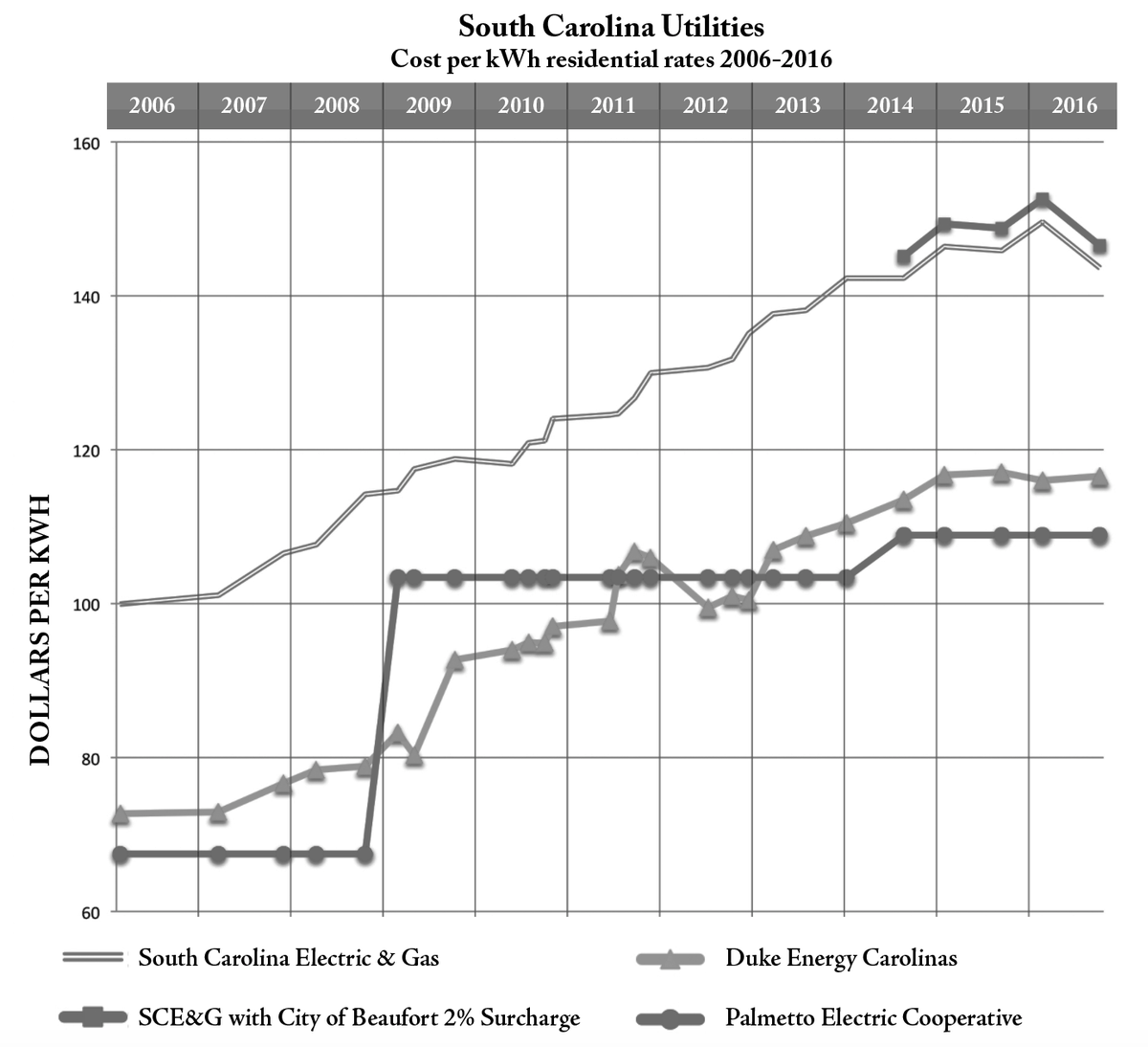Top photo: To make complex (and boring) electrical base rates more understandable (and interesting) they are often shown in per thousand kilowatthour increments, as they are here, because a thousand kWhs is close to what a small household uses in an average month.
Sources: The South Carolina Office of Regulatory Staff website, The Palmetto Electric Cooperative Marketing Dept., and the minutes of the June 3, 2014 Beaufort City Council meeting.
By Bill Rauch
After my previous column about the city of Beaufort’s recent economic development spending spree I received an email from a reader that went like this: “Look at chart 5.6A for correct info then make a correction in the paper. S.C is actually lower than most Eastern states.”
A couple of things came to my mind. First, after reading that Beaufort’s general fund has increased by nearly a million dollars each year for the past seven years (from $13,913,341 to $19,387,961), and that the tax rate for city taxpayers – including businesses – has been raised virtually annually to pay for the new spending, and that to support the spending the city has imposed new fees too, and that the mayor who is leading the spending charge is also spending an additional quarter of a million dollars every four years to keep his $5,000-a-year job, what concerns this reader is that our electrical rates are lower than “most Eastern states?”
To me, that’s akin to saying, “Okay, so Kim Jong-un now has workable nuclear warheads, but my information on his ballistic missiles aren’t as accurate as you say they are.”
My next thought was … “most Eastern states?” What about Georgia, North Carolina, Florida, Tennessee and maybe Ohio? That’s who we’re competing against. The Northeast has been losing population and businesses for the past generation, and the high costs of living and doing business there are the leading reasons why.
And finally, my bet was the reader was confusing South Carolina Electric & Gas (SCE&G) rates with the blended base rates of all the utilities serving South Carolina. In fact that’s exactly what the referenced “chart 5.6A”
The website www.eia.gov/electricity/monthly/epm_table_grapher.cfm?t=epmt_5_6_a reflects the statewide average; and although South Carolina is high among the South Atlantic states at 12.68 cents per kilowatthour (kWh), it is, in fact, still lower than all the New England states.
The reader’s point is hereby acknowledged.
But here’s the thing: SCE&G’s current residential base rate is 14.37 cents per kWh, which makes it higher than the blended base rate of any state in the Southeast and in fact, Chart 5.6A shows, the closest states that have higher blended base rates are Maryland to the north, Michigan to the northwest, and California to the west.
That’s bad.
Then add to SCE&G’s sky-high rate the city of Beaufort’s 2-percent surcharge on top of the standard 5-percent franchise fee and you have an actual residential rate in Beaufort of 15.72 cents per kWh.
Between SCE&G’s efforts and those of the Beaufort City Council, at 15.72 cents per kWh the city of Beaufort is a tiny island in all the Southeast that has the highest investor-owned electricity rates this side of New York, Michigan and California.
It’s no secret that businesses seeking to relocate, or start-up, look at utility costs. It’s a line on every pro forma. The importance of the line to decision-making depends upon how much electricity the business is expecting to use. Law offices don’t use much electricity. Digital businesses use more. And manufacturing companies like those Beaufort would like to attract to its Commerce Park typically use even more.
Yet in the 10 pages of adopted minutes that reflect the discussion of the 2-percent franchise fee surcharge at the Beaufort City Council’s June 3, 2014, special meeting, there is no reference to any discussion at that meeting of how the surcharge might affect the city’s economic development efforts.
This city administration (Mayor Keyserling who is most often joined in these votes by Councilmembers McFee and Murray) says it is committed to creating jobs so that Beaufort’s young people don’t have to move away to get good work. Sounds good. But the results haven’t matched up to the big talk (and big spending), and making the same mistakes New England has made probably won’t make things better.
Blakely Williams, the Beaufort Regional Chamber of Commerce’s savvy president and CEO, didn’t return repeated phone calls last week. Why would she? The city of Beaufort is one of the chamber’s chief funders. The question I left on her voicemail was: “Hi Blakely. Just need a quick comment on the success or lack thereof of the city of Beaufort’s economic development efforts, the Commerce Park, the Digital Corridor, etc. …”
Our mothers’ wisely taught us, “If you can’t say anything nice, don’t say anything at all.”
The savvy Ms. Williams, it seems, learned her lesson better than this writer.
Bill Rauch was the mayor of Beaufort from 1999-2008. Email Bill at TheRauchReport@gmail.com.






